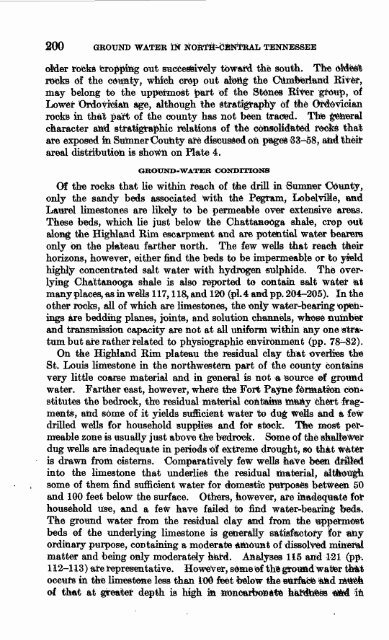GROUND WATER IN NORTH-CENTRAL TENNESSEE
GROUND WATER IN NORTH-CENTRAL TENNESSEE
GROUND WATER IN NORTH-CENTRAL TENNESSEE
You also want an ePaper? Increase the reach of your titles
YUMPU automatically turns print PDFs into web optimized ePapers that Google loves.
200 <strong>GROUND</strong> <strong>WATER</strong> Mr NOBT&K5ENTRAL <strong>TENNESSEE</strong><br />
older rocks crowing out successively toward the south. The<br />
rocks of the county, which crop out along the Cumberland River,<br />
may belong to the uppermost |>art of the Stones River group, of<br />
Lower OrdovMan age, although the stratigraphy of the Ordovician<br />
rocks in that part of the county has not been traced. Thte general<br />
character and stratigra^hic relations of the consolidated rocks tha't<br />
are exposed in Suinner County are discussed on plages -33-^-58, an4 their<br />
areal distribution is shown on Plate 4.<br />
<strong>GROUND</strong>-<strong>WATER</strong> CONDITIONS<br />
Of the rocks that lie within reach of the drill hi Sumner County,<br />
only the sandy beds associated with the Pegram, Lobelvile, and<br />
Laurel limestones are likely to be permeable over extensive areas.<br />
These beds, which lie just below the Chattanooga shale, crop out<br />
along the Highland Rim escarpment and are potential water bearers<br />
only on the plateau farther north. The few wells that reach feheir<br />
horizons, however, either find the beds to be impermeable or to yield<br />
highly concentrated salt water with hydrogen sulphide. The over<br />
lying Chattanooga shale is also reported to contain salt watet at<br />
many places, as in wells 117,118, and 120 (pi. 4 and pp. 204-205). In the<br />
other rocks, all of which are limestones, the only water-bearing "open<br />
ings are bedding planes, joints, and solution channels, whose number<br />
and transmission capacity are not at all uniform within any one stra<br />
tum but are rather related to physiographic environment (pp. 78-82).<br />
On the Highland Rim plateau the residual clay that overlies the<br />
St. Louis limestone in the northwestern part of the county contains<br />
very little coarse material and in general is not a source 0f ground<br />
water. Farther east, however, where the Fort Payne formation con<br />
stitutes the bedrock, the residual material cont/aias many chert frag<br />
ments, and some of it yields sufficient water to dug weUs and a few<br />
drilled wells for household supplies and fot stock. The most per<br />
meable zone is usually just above the bedrock. Some of the 'shallower<br />
dug Wells are inadequate in periods of extreme drought, so that Water<br />
is drawn from cisterns. Comparatively few wells haVe been dflUed<br />
into the limestone that underlies the residual material, alt&ougli<br />
some of them find sufficient water for domestic purpose's between 50<br />
and 100 feet below the surface. Others, however, are inadequate Jot<br />
household use, and a fefr have failed to find water-bearing t»ed&.<br />
The ground water from the residual clay and from the uppermost<br />
beds of the underlying limestone is generally satisfactory Ifof any<br />
ordinary purpose, containing a moderate amount of dissolved mineral<br />
matter and being only moderately hard. Analyses 115 and 1-21 (pp.<br />
112-113) are representative. However, someof the grottttd waiter tkat<br />
occurs in the limestone less than i.00 feet fcelow the surface aftd mttck<br />
of that at greater depth is high in n'0ncarbo»a*fc hardness *»M ra

















